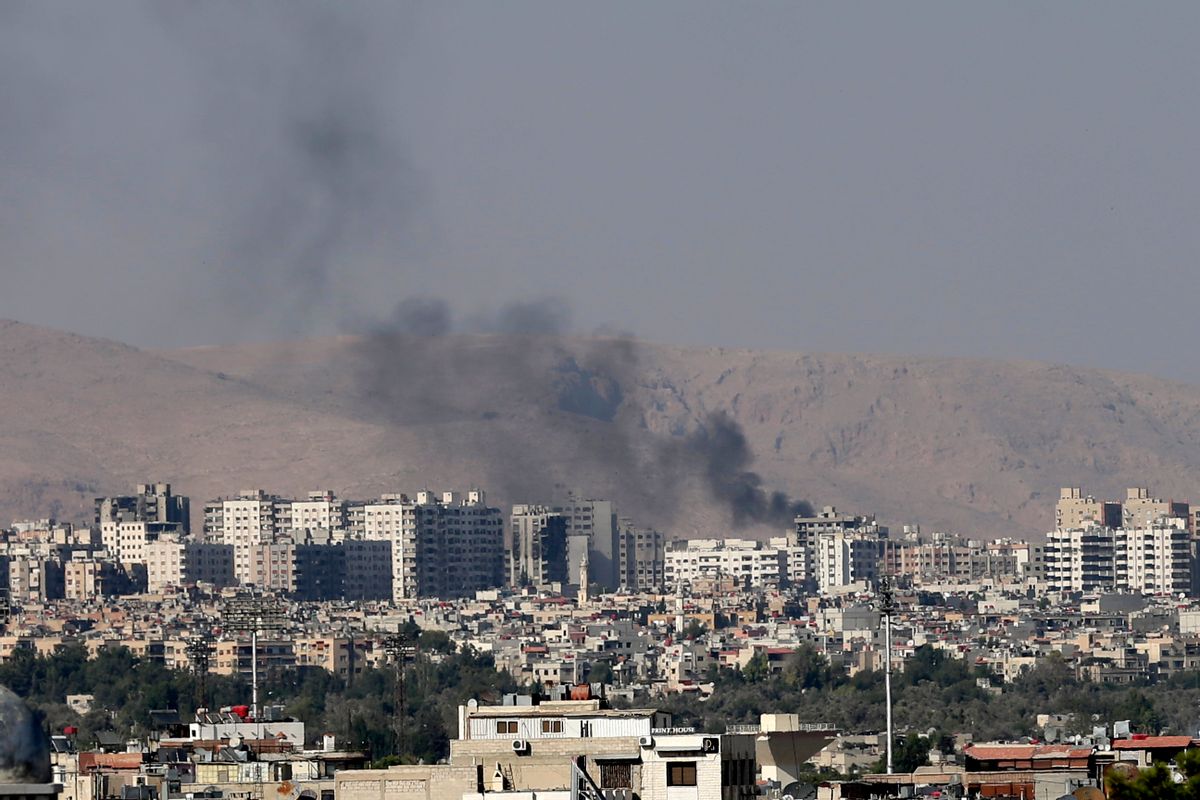The long-simmering conflict between the United States and Iran is fast escalating toward war. The battlefield is the desert expanse of eastern Syria where civil war has raged for the last five years. Tehran wants to keep U.S. forces out of the area, while Washington wants to use the region to wage war against Iran’s ally, Syria.
After 15 years of unsuccessful war in Afghanistan and Iraq, Secretary of State Rex Tillerson says the Trump administration is pursuing a policy of "regime change" in Iran that might lead to a third U.S. ground war in the Middle East since 2001.
Restraint is breaking down. While President Obama resisted U.S. involvement in the Syrian civil war, Trump has approved it. While Obama pursued dialog with Iran, Trump has embraced the new Saudi crown prince, Mohammed bin Salman, who laid down his country’s new, harsher line in April. ‘We will not wait until the battle is in Saudi Arabia," he said, "but we will work so the battle is there in Iran."
Secretary of Defense James Mattis, while resisting White House pressure for rapid escalation, has given battlefield commanders more leeway to attack Iranian-backed forces. The result is a series of unprecedented incidents that have Washington experts asking “Is Trump preparing for a conflict with Iran?"
- On May 18, the United States attacked a convoy of Iranian-backed militiamen in southern Syria, reportedly killing eight fighters.
- On June 7, ISIS struck inside Iran for the first time, with a pair of suicide attacks that killed 18 people. One top Iranian official said the United States, by supporting Saudi Arabia, effectively supports ISIS.
- On June 18, Iran fired ballistic missiles at ISIS positions in eastern Syria, in retaliation for the two terror attacks. It was the first time Iran has used such heavy weaponry on the Syrian battlefield.
- That same day U.S. forces shot down a Syrian fighter jet, the first time the U.S. has attacked the air force of Iran’s ally.
As the United States and Iran compete for battlefield advantages, here are six places their struggle might erupt into war.
1. Raqqa
After ISIS is defeated the Syrians, backed by Iran, want to reestablish the authority of the President Bashar Assad’s regime throughout the area. The U.S.-backed forces want to pivot from the fight against ISIS to take on the Syria government directlyRaqqa is where these ambitions will collide.
2. Eastern Syria
As the sway of ISIS shrinks, Assad and his allies have launched an operation to “take control of the eastern desert in Syria,” which borders on Iraq. They want to drive out the Sunni extremists, but also prevent other rivals — namely the United States — from filling the void.
Iran fears that that U.S.-backed Kurdish fighters in the Syrian Democratic Forces will seize northern Syria while other U.S.-backed rebels take control of the rest of the Iraqi border.
Iran wants to deny the United States and its allies a sanctuary, while the U.S. military seeks freedom to operate in the area. Both sides hope to benefit from the changing status quo in eastern Syria to their advantage. Only one can prevail.
3. Unfriendly skies
American, Iranian, Syrian, Russian, and Turkish air forces are all active in the airspace over Syria — and all are becoming less tolerant of the others.
When the U.S. shot down a Syrian jet last week, Russia warned it would target all foreign aircraft west of the Euphrates River. When the Iranians sent drones over U.S.-controlled territory, the United States shot downtwo of them.
The conflict is escalating vertically, as well as horizontally.
4. Missiles
Iran compensates for its weak army and air force with a potent ballistic missile force that the United States regards as a threat to Israel and the region. The U.S. Congress just voted to increase sanctions on Iran for its ballistic missile program.
Iran’s decision to use the missiles in eastern Syria was more than a message to ISIS, said Iranian Gen. Ramazan Sharif in a television interview.
"The Saudis and Americans are especially receivers of this message," Sharif said. "Obviously and clearly, some reactionary countries of the region, especially Saudi Arabia, had announced that they are trying to bring insecurity into Iran."
If the United States is threatening Iran with regime change, and Iran uses missiles when it feels most threatened, then missile warfare is more likely.
5. Hostages
Americans of a certain age will never forget that the Iranians took 52 Americans hostages in 1979 and held them for more than a year. Another hostage situation would inflame American public opinion and be used to justify escalation.
When the Iranian navy detained 10 U.S. sailors whose patrol boats strayed into Iranian waters in January 2016, the sailors were released within 24 hours. Secretary of State John Kerry used his working relationship with Iranian foreign minister Mohammad Javad Zarif to secure their freedom.
Secretary of State Rex Tillerson has no such communication channel with the Iranians, and no interest in having one. If such an incident occurred again, opened-ended escalation is much more likely than quick resolution.
6. Special forces
Both Iran and the United States have deployed elite military forces to the Syrian battlefield.
More than 500 U.S. Special Operations forces are advising and training anti-Assad forces in Syria. An equally big contingent of Iranian Revolutionary Guard forces, under the command of legendary general Qasem Soleimani, are advising and fighting with pro-Assad forces.
In a crisis, military and civilian commanders on both sides are less likely to back down, compromise or negotiate if their most prestigious forces are fighting and dying.
Ali Vaez, an analyst for the International Crisis Group, has noted, if the U.S. ends up going to war against Iran, it would “make the Afghan and Iraqi conflicts look like a walk in the park.”




Shares